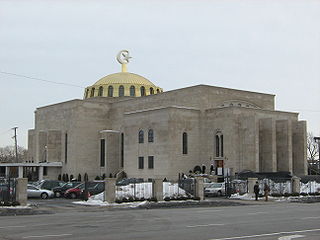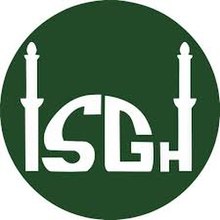
A mosque is a place of worship for Muslims. Any act of worship that follows the Islamic rules of prayer can be said to create a mosque, whether or not it takes place in a special building. Informal and open-air places of worship are called musalla, while mosques used for communal prayer on Fridays are known as jāmiʿ. Mosque buildings typically contain an ornamental niche (mihrab) set into the wall that indicates the direction of Mecca (qiblah), ablution facilities and minarets from which calls to prayer are issued. The pulpit (minbar), from which the Friday (jumu'ah) sermon (khutba) is delivered, was in earlier times characteristic of the central city mosque, but has since become common in smaller mosques. Mosques typically have segregated spaces for men and women. This basic pattern of organization has assumed different forms depending on the region, period and denomination.

In Islam, Friday prayer or Congregational prayer is a prayer (ṣalāt) that Muslims hold every Friday, after noon instead of the Zuhr prayer. Muslims ordinarily pray five times each day according to the sun's sky path regardless of time zones. Jumu’ah means Friday in the Arabic language. Al-Jumu'ah is derived from the verb ijta'ama which means the gathering together of people.

According to statistics from 2010, about 15% of Singapore's resident population aged 15 years and over are Muslims. A majority of Malays are Sunni Muslims. 17 per cent of Muslims in Singapore are of South Asian origin. Other adherents include those from the Chinese, Arab and Eurasian communities. The majority of Muslims in Singapore are traditionally Sunni Muslims who follow the Shafi'i school of thought or the Hanafi school of thought.

Islam in Haiti consists of a small minority of Muslims forming less than 1% of the total population, composed of locals and foreign immigrants. A number of mosques and Islamic organizations are present in the country.

Statistics for Islam in Barbados estimate a Muslim population of over 4000, most of whom are immigrants or descendants of immigrants from the Indian state of Gujarat. A few immigrants from Guyana, Trinidad, South Asia, and the Middle East, as well as about 200 native-born persons, constitute the rest of the growing Muslim community, representing 1.50 percent of the population Close to 90 percent of all Barbadians are of African descent (Afro-Bajans), mostly descendants of the slave labourers on the sugar plantations. The remainder of the population includes groups of Europeans (Euro-Bajans), Asians, Bajan Hindus and Muslims, and an influential Middle Eastern (Arab-Bajans) group mainly of Syrian and Lebanese descent.

According to 2007 statistics released by the U.S. Department of State concerning Islam in Nicaragua, there are approximately 1,200 to 1,500 Muslims, mostly Sunnis who are resident aliens or naturalized citizens from Palestine, Libya, and Iran or natural-born Nicaraguan citizens born to both of the two groups. The Islamic Cultural Center in Managua serves as the primary salaat (prayer) center for Muslims in the city, with approximately 320 men attending on a regular basis. Muslims from Granada, Masaya, Leon, and Chinandega also travel to the Managua center for Friday prayers. Granada, Masaya, and Leon have smaller prayer centers in the homes of prominent local Muslims. In May 2007 the Sunni leader of the Managua prayer center was dismissed, due to the increase in Iranian influence in the Muslim community and was to be replaced by a Shi'a religious leader. By the end of the reporting period the Shi'a leader had not been identified.

The Islamic Foundation of Greater St. Louis (IFGSTL) is an Islamic organization composed of two mosques. The first mosque, Masjid Bilal, is located in downtown St. Louis, on W Pine Blvd, next to the campus of Saint Louis University. The second and larger mosque, Daar-Ul-Islam, is located in Ballwin, Missouri, at 517 Weidman Road, and includes an Islamic funeral home with 5 cemeteries and social services including job training and English classes. A donation charity known as Baitulmal that provides donated items and food to those in need is also hosted by IFGSTL.
Al-Islah Mosque, also known as the Al-Islah Islamic Center or the Al-Islah Jame Masjid, is a mosque following the Sunni tradition in Hamtramck, Michigan. It was founded in 2000 by immigrants from Bangladesh, of which a large community exists in Hamtramck. Al-Islah Mosque is currently being expanding, it to a bigger building next door.
Mid-Hudson Islamic Association is an Islamic Association located at Masjid Al Noor in Wappingers Falls, NY, United States. The group was founded in the 1980s in response to the large addition of Muslim families in the Hudson River Valley. The group originally met in their own homes for prayers and social/religious events. In 1990, they opened a mosque that provided prayer space, an educational Sunday school, and multiple community services. The building has three stories - the men's prayer hall is located on the ground floor, and the women's prayer balcony is on the second floor overlooking the main prayer hall. The basement of the mosque serves as a community hall. A small minaret was added to the north side of the building sometime after the original construction.

The American Society of Muslims was a predominantly African-American association of Muslims which was the direct descendant of the original Nation of Islam. It was created by Warith Deen Mohammed after he assumed leadership of the Nation of Islam upon the death of his father Elijah Muhammad. Imam W. Deen Mohammed changed the name of the Nation of Islam to the "World Community of Islam in the West" in 1976, then the "American Muslim Mission" in 1981, and finally the "American Society of Muslims".

According to Sahih al-Bukhari, Muhammad said "Do not prepare yourself for a journey except to three Mosques: Masjid al-Haram, the Mosque of Aqsa (Jerusalem) and my Mosque." In the Islamic tradition, the Kaaba is considered the holiest site, followed by the Al-Masjid an-Nabawi and Al-Aqsa Mosque.
Islam in Delaware is an established religion. Although it is unknown how many Muslims live in the state, Delaware has at least five mosques and a sizable Muslim population.

Masjid Annur Islam Center in Sacramento, California is the largest mosque in the greater Sacramento area of Northern California.

The Islamic Education Institute of Texas (IEIT), also known as Darul Arqam Islamic School District (DAISD) and Darul Arqam Schools is a network of Islamic schools in Greater Houston, Texas, United States. The organization is a subsidiary of the Islamic Society of Greater Houston (ISGH). IEIT is headquartered in Southwest Management District in Houston.

The city of Houston which historically was centered on Protestant Christianity, and a part of the Bible Belt, is now home to many different religions owing to its large ethnic diverse population.

Houston, in the U.S. state of Texas, is home to a significant number of Muslim Americans. As of 2012 it has the largest Muslim population in Texas and the largest Muslim population in the Southern United States. That year, Kate Shellnut of the Houston Chronicle wrote that "Some estimate that Muslims make up 1.2 percent of the city's population." As of 2012 the estimated population of Muslims in Houston was around 63,000. As of today there are over 209 mosques and storefront religious centers, with the largest being the Al-Noor Mosque of the Islamic Society of Greater Houston (ISGH).
As of the 2010 U.S. Census the number of people in the Houston area of Pakistani origin was counted as 27,856. In 2007 the Pakistani-American Association of Greater Houston (PAGH) stated that about 60,000 people of Pakistani origin lived in Greater Houston and that many of them lived in Southwest Houston. As of 2000, over 70% of the Muslims in Houston are Pakistani or Indian. More recent estimates show the number of the Pakistani community in Houston exceeding 100,000.

The Aberdeen Mosque and Islamic Centre (AMIC) is the main mosque and Islamic centre in Aberdeen, Scotland. AMIC is a charitable, non profitable, non political organisation. Its purpose is to hold congregational prayers and Islamic religious activities, with provision of free religious services to members of the Muslim community relating to Islamic marriage, birth, death and burial in accordance with Scottish law. AMIC also aims to promote unity and provide channels for better communication and understanding between the Muslims and non Muslims in the area. The mosque contributes to the local community by promoting and participating in projects related to areas of social concern.

Masjid Al-Jamia is a Sunni mosque in West Philadelphia. It was founded in 1988 by members of the Muslim Students Association at the University of Pennsylvania . Eight years later, the mosque became independent from the Penn MSA and, around 2009, acquired ownership of the building. Located at 4228 Walnut Street, in a historic building formerly occupied by the Commodore Theatre, the mosque currently serves a large and diverse Muslim population in the neighborhood. The mosque's name itself signals its importance to the community, as the Arabic etymology suggests. In Arabic, Masjid Al-Jamia means “the congregational mosque”, typically where Muslims meet for Friday prayers.
Masjid Al Mu'mineen is a Sunni orthodox mosque located on the near east side of Indianapolis, Indiana. Established in 2001, it is the third Islamic place of worship founded in the city of Indianapolis and serves a weekly prayer congregation of 150-250 men, women, and children. Masjid Al Mu'mineen houses the SHARE Center Inc., which is a 501(c)3 nonprofit organization that acts as the mosque's community service arm. SHARE Center initiatives include an offender re-entry program called Siratal Mustaqeem, a summer feeding program sponsored by the U.S. Department of Agriculture & Indiana Department of Education, and a food pantry that serves approximately 100 households per month.















